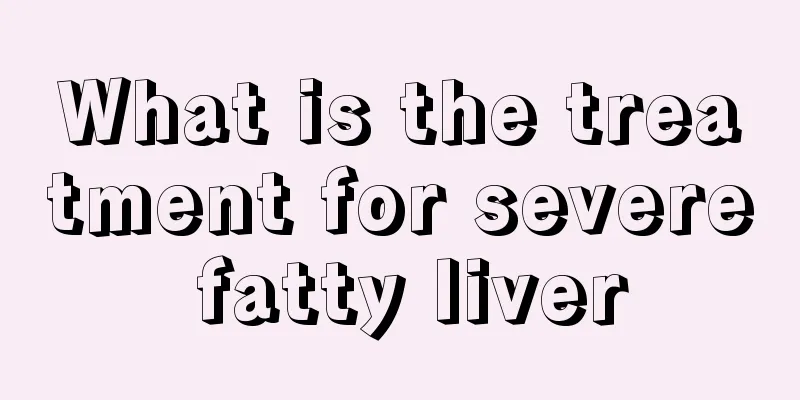What is the treatment for severe fatty liver

|
Friends always fail to take responsibility for their own bodies in life, and often they don’t discover the disease until it has become serious. For the treatment of severe fatty liver, drugs are generally used as auxiliary treatment, and diet and lifestyle adjustments are used as continuous treatment. Control the underlying disease or concomitant disease Insulin resistance and increased free fatty acids leading to lipid metabolism disorders are one of the causes of fatty liver. Actively improving insulin resistance and abnormal glucose and lipid metabolism can prevent liver cells from developing from fatty degeneration to fatty hepatitis. Inhibiting the activity of the rate-limiting enzyme that synthesizes cholesterol and reducing the synthesis of cholesterol and fatty acids is also an important measure to prevent the progression of fatty liver. Oxygen stress/lipid peroxidation is another major factor in the progression of fatty liver disease and is the key to the development of fatty degeneration into fatty hepatitis. Therefore, protecting the liver cell membrane and improving the antioxidant capacity of liver cells can reduce the fat content in the liver, promote the regression of fatty liver, prevent and treat hepatitis, necrosis and fibrosis, and stop the progression of chronic liver disease, which is of positive significance for alleviating or delaying the disease. In fact, there is no panacea for fatty liver disease at home and abroad so far. To prevent and treat modern urban diseases such as obesity-related fatty liver, losing weight through dieting, exercise and other measures is more important than liver-protecting drug treatment. In particular, the treatment of simple obesity-related fatty liver mainly focuses on changing lifestyle, which is also the only effective treatment option for simple fatty liver. However, for those who have not been relieved after more than 3 to 6 months of treatment, attention should be paid to: whether the primary cause or predisposing factor is still at work; whether the pathogenic factors are unclear and the condition has developed into fatty liver hepatitis. Liver protection drugs are an auxiliary treatment Liver-protecting drugs are mainly used for patients with persistent abnormal serum transaminase or inflammation, necrosis and fibrosis in liver biopsy; patients with cryptogenic fatty liver whose primary cause is unknown after comprehensive examination; patients with simple fatty liver who have not responded to basic treatment for 6 months or whose basic treatment may induce and cause liver disease deterioration. The main medication methods are: choose 1 to 2 liver-protecting drugs for treatment for more than half a year, or until serum transaminase returns to normal and imaging examinations indicate that fatty liver has subsided. In a small number of patients, even if the cause is removed, the disease may still progress to irreversible cirrhosis. |
<<: What can I eat to treat fatty liver?
>>: What should patients with fatty liver pay attention to?
Recommend
How to self-examine liver cancer to detect it as early as possible? Reveal the self-examination method of liver cancer
Everyone must know about liver cancer self-examin...
Nursing diagnosis after laryngeal cancer surgery
When people talk about cancer, they are really te...
Early symptoms of bladder cancer
Bladder cancer refers to a malignant tumor that o...
How to remove the lime smell from eggs
In many areas of my country, people like to eat p...
There are 9 misunderstandings about lung cancer. To prevent lung cancer, you need to have these six habits!
Lung cancer in China is in a period of rapid incr...
Which hospital is good for treating colorectal cancer
Colorectal cancer is a common malignant tumor dis...
Tips to effectively remove surgical scars, you deserve it!
Surgical scars generally refer to a type of hyper...
Characteristics of a simple girl
In this complex social environment, everyone'...
What kind of bras should pregnant women wear?
Every woman has to wear a bra regularly, but in l...
Pneumoconiosis is relatively hidden in the early stages, so how to protect yourself is very important! ——Pay attention to occupational health
Pneumoconiosis is a type of occupational chronic ...
What is the cause of left lung bronchiectasis
Fibrosis causes the muscles and elastic tissues o...
How to do the five major nursing tasks for primary liver cancer before surgery
Primary liver cancer is a type of cancer. Once yo...
Can thrombotic thrombocytopenic purpura be cured? What are the methods?
Thrombotic thrombocytopenic purpura is a disease ...
What are the effects of Laoshan White Snake Grass Water
Laoshan White Snake Grass Water, which many peopl...
How many types of chronic nephritis are there?
Nephritis is the most common disease of the kidne...









